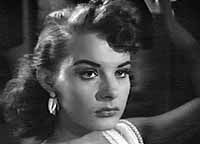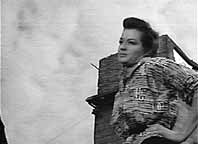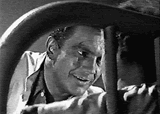Fuller's characters are both fallible and infallible narrative filters.
According to Chatman, the focal point of a character can be aligned with the narrative slant of the scene (the textual intent) or, in the case of fallible filtration, outside of it and the overall ideology of the film. Fuller's stories feature political sloganeering, bombast, and characters speaking in headlines, but they also contain a strong element of the newspaper tradition: objective reporting. According to historian Bill Stott, restraint had become one dominant mode of reporting in the 1930s. Adjectives were eschewed for concrete nouns and verbs to create an objective, documentary voice; but, Stott maintains that behind a WeeGee or Walker Evans photograph, was a presence that demanded that we care about life in the city or the plight of the sharecropper. Fuller's narratives replicate this paradox: apparent neutrality couched in judgement.
 Pickup On South Street (1952). Jean Peters, the film's moral center and the catalyst to Widmark's redemption, moves from being a fallible to an infallible character filter. The film opens with her on a subway. The eyeline matches of Government agents and pick-pocket Widmark penetrate her. She is the object of their look, but her gaze is absently distracted. She doesn't return their looks. This lack of knowledge, both about being watched and the mission Richard Kiley (Joey) has sent her on, illustrates her lack of authority within the text. Later, Candy comes to knowledge during a meeting with her ex-boyfriend and his "friends." Peters in long-shot and medium close-ups moves about a room, talking about how Widmark has accused her connections of being "commies." They say nothing, but a series of static, close up cut-ins--a man smoking a cigar, another holding a cigarette in a holder, Joey's squinty, sweaty eyes--visually separates her from them. Fuller's use of Candy's eyeline matches illustrates their guilt and links her to the narrative slant ("commies" are totalitarian and therefore evil). Moreover, Candy's looks are interrogative; in contrast to her earlier distracted gaze on the subway, she is now an infallible, knowing character.
Pickup On South Street (1952). Jean Peters, the film's moral center and the catalyst to Widmark's redemption, moves from being a fallible to an infallible character filter. The film opens with her on a subway. The eyeline matches of Government agents and pick-pocket Widmark penetrate her. She is the object of their look, but her gaze is absently distracted. She doesn't return their looks. This lack of knowledge, both about being watched and the mission Richard Kiley (Joey) has sent her on, illustrates her lack of authority within the text. Later, Candy comes to knowledge during a meeting with her ex-boyfriend and his "friends." Peters in long-shot and medium close-ups moves about a room, talking about how Widmark has accused her connections of being "commies." They say nothing, but a series of static, close up cut-ins--a man smoking a cigar, another holding a cigarette in a holder, Joey's squinty, sweaty eyes--visually separates her from them. Fuller's use of Candy's eyeline matches illustrates their guilt and links her to the narrative slant ("commies" are totalitarian and therefore evil). Moreover, Candy's looks are interrogative; in contrast to her earlier distracted gaze on the subway, she is now an infallible, knowing character.
 China Gate (1957). Angie Dickinson wants to get her biracial child out of Viet Nam. Fuller's editing and choice of shots identifies with her quest, during a meeting with the mercenary force and her estranged husband. Captain Caumont (Paul Dubov) says, "Now I don't want trouble over this woman." A low angle medium shot of Dickinson follows. Caumont's offscreen voice: "She has a job to do." Low angle shot on her child dwarfed by rubble and sky. Caumont's voice: "We will finish it." Her job isn't just to help blow up "red" munitions, but as the shots linked to Dubov's comments indicate, to liberate her child. She has become our empathetic center for reading the film.
China Gate (1957). Angie Dickinson wants to get her biracial child out of Viet Nam. Fuller's editing and choice of shots identifies with her quest, during a meeting with the mercenary force and her estranged husband. Captain Caumont (Paul Dubov) says, "Now I don't want trouble over this woman." A low angle medium shot of Dickinson follows. Caumont's offscreen voice: "She has a job to do." Low angle shot on her child dwarfed by rubble and sky. Caumont's voice: "We will finish it." Her job isn't just to help blow up "red" munitions, but as the shots linked to Dubov's comments indicate, to liberate her child. She has become our empathetic center for reading the film.
 Underworld USA (1961). A confession scene in which Tolly convinces dying gangster Vic Faraar that he'll forgive him for murdering his father if he'll name his cohorts. The sequence is shot in alternating shot/rev-shots--low angle cheats from behind the bed to emphasize Tolly, and high-angle positions to situate Faraar. Screen duration is equal (41 seconds for Tolly; 40 seconds for Faraar) but the textual intent is fallible filtration. After hearing the confession, Tolly refuses to forgive Faraar and spits out "fink" as a final epitaph. Tolly achieves his goal, but the visual cues suggest a moral flaw in his quest. His twisted, menacing grin is framed behind the bars of the bed to suggest both desired distance between audience and protagonist and to imply that there is something criminal in his behavior. The effect is subtle, but Fuller's mise-en-scene belies the reporter's attempt at objectivity.
Underworld USA (1961). A confession scene in which Tolly convinces dying gangster Vic Faraar that he'll forgive him for murdering his father if he'll name his cohorts. The sequence is shot in alternating shot/rev-shots--low angle cheats from behind the bed to emphasize Tolly, and high-angle positions to situate Faraar. Screen duration is equal (41 seconds for Tolly; 40 seconds for Faraar) but the textual intent is fallible filtration. After hearing the confession, Tolly refuses to forgive Faraar and spits out "fink" as a final epitaph. Tolly achieves his goal, but the visual cues suggest a moral flaw in his quest. His twisted, menacing grin is framed behind the bars of the bed to suggest both desired distance between audience and protagonist and to imply that there is something criminal in his behavior. The effect is subtle, but Fuller's mise-en-scene belies the reporter's attempt at objectivity.
Samuel Fuller is a brilliant filmmaker with a narrative technique, a cinema fist, all his own. His use of objective, caring reporting, post-traumatic-like collisions of narrative modes and mini-expository essays place his films outside the usual Hollywood paradigm. His world view is sordid and graphic. Perhaps Fuller's attitude of destructive love was anchored during his tenure on the sensationalist Graphic. Graphic stories dealt with crime and the lurid side of love: a professor kills his coed lover because she "Had Begged for Dope" (June 20, 1929, 5); "Children Tell of Trysts of Mother and Vestryman" (June 21, 1929, 2); "Mabel Wayne Called Love Thief" (June 21, 1929, front page); "Margaret Lawrence Slain by Lover" (June 19, 1929, 2); "Love Crazed Ex-Priest Shoots Girl, Kills Self" (June 5, 1929, 2). Whatever the motivation, Fuller's vision is encased in a stunted world, and his gutter graphics more fully signify the very need of love, through its glaring absence.
Grant Tracey is the editor of Literary Magazine Review and an assistant professor at the University of Northern Iowa.

























 Pickup On South Street (1952). Jean Peters, the film's moral center and the catalyst to Widmark's redemption, moves from being a fallible to an infallible character filter. The film opens with her on a subway. The eyeline matches of Government agents and pick-pocket Widmark penetrate her. She is the object of their look, but her gaze is absently distracted. She doesn't return their looks. This lack of knowledge, both about being watched and the mission Richard Kiley (Joey) has sent her on, illustrates her lack of authority within the text. Later, Candy comes to knowledge during a meeting with her ex-boyfriend and his "friends." Peters in long-shot and medium close-ups moves about a room, talking about how Widmark has accused her connections of being "commies." They say nothing, but a series of static, close up cut-ins--a man smoking a cigar, another holding a cigarette in a holder, Joey's squinty, sweaty eyes--visually separates her from them. Fuller's use of Candy's eyeline matches illustrates their guilt and links her to the narrative slant ("commies" are totalitarian and therefore evil). Moreover, Candy's looks are interrogative; in contrast to her earlier distracted gaze on the subway, she is now an infallible, knowing character.
Pickup On South Street (1952). Jean Peters, the film's moral center and the catalyst to Widmark's redemption, moves from being a fallible to an infallible character filter. The film opens with her on a subway. The eyeline matches of Government agents and pick-pocket Widmark penetrate her. She is the object of their look, but her gaze is absently distracted. She doesn't return their looks. This lack of knowledge, both about being watched and the mission Richard Kiley (Joey) has sent her on, illustrates her lack of authority within the text. Later, Candy comes to knowledge during a meeting with her ex-boyfriend and his "friends." Peters in long-shot and medium close-ups moves about a room, talking about how Widmark has accused her connections of being "commies." They say nothing, but a series of static, close up cut-ins--a man smoking a cigar, another holding a cigarette in a holder, Joey's squinty, sweaty eyes--visually separates her from them. Fuller's use of Candy's eyeline matches illustrates their guilt and links her to the narrative slant ("commies" are totalitarian and therefore evil). Moreover, Candy's looks are interrogative; in contrast to her earlier distracted gaze on the subway, she is now an infallible, knowing character.
 China Gate (1957). Angie Dickinson wants to get her biracial child out of Viet Nam. Fuller's editing and choice of shots identifies with her quest, during a meeting with the mercenary force and her estranged husband. Captain Caumont (Paul Dubov) says, "Now I don't want trouble over this woman." A low angle medium shot of Dickinson follows. Caumont's offscreen voice: "She has a job to do." Low angle shot on her child dwarfed by rubble and sky. Caumont's voice: "We will finish it." Her job isn't just to help blow up "red" munitions, but as the shots linked to Dubov's comments indicate, to liberate her child. She has become our empathetic center for reading the film.
China Gate (1957). Angie Dickinson wants to get her biracial child out of Viet Nam. Fuller's editing and choice of shots identifies with her quest, during a meeting with the mercenary force and her estranged husband. Captain Caumont (Paul Dubov) says, "Now I don't want trouble over this woman." A low angle medium shot of Dickinson follows. Caumont's offscreen voice: "She has a job to do." Low angle shot on her child dwarfed by rubble and sky. Caumont's voice: "We will finish it." Her job isn't just to help blow up "red" munitions, but as the shots linked to Dubov's comments indicate, to liberate her child. She has become our empathetic center for reading the film.
 Underworld USA (1961). A confession scene in which Tolly convinces dying gangster Vic Faraar that he'll forgive him for murdering his father if he'll name his cohorts. The sequence is shot in alternating shot/rev-shots--low angle cheats from behind the bed to emphasize Tolly, and high-angle positions to situate Faraar. Screen duration is equal (41 seconds for Tolly; 40 seconds for Faraar) but the textual intent is fallible filtration. After hearing the confession, Tolly refuses to forgive Faraar and spits out "fink" as a final epitaph. Tolly achieves his goal, but the visual cues suggest a moral flaw in his quest. His twisted, menacing grin is framed behind the bars of the bed to suggest both desired distance between audience and protagonist and to imply that there is something criminal in his behavior. The effect is subtle, but Fuller's mise-en-scene belies the reporter's attempt at objectivity.
Underworld USA (1961). A confession scene in which Tolly convinces dying gangster Vic Faraar that he'll forgive him for murdering his father if he'll name his cohorts. The sequence is shot in alternating shot/rev-shots--low angle cheats from behind the bed to emphasize Tolly, and high-angle positions to situate Faraar. Screen duration is equal (41 seconds for Tolly; 40 seconds for Faraar) but the textual intent is fallible filtration. After hearing the confession, Tolly refuses to forgive Faraar and spits out "fink" as a final epitaph. Tolly achieves his goal, but the visual cues suggest a moral flaw in his quest. His twisted, menacing grin is framed behind the bars of the bed to suggest both desired distance between audience and protagonist and to imply that there is something criminal in his behavior. The effect is subtle, but Fuller's mise-en-scene belies the reporter's attempt at objectivity.